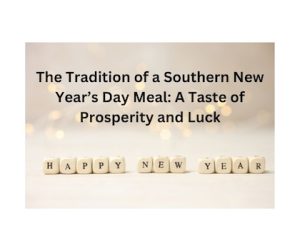The Tradition of a Southern New Year’s Day Meal: A Taste of Prosperity and Luck
December 30, 2024As the clock strikes midnight on New Year’s Eve, many across the South prepare not only to ring in the new year but also to honor a culinary tradition steeped in history and superstition. The traditional Southern New Year’s Day meal, featuring black-eyed peas, collard greens, pork, and cornbread, is more than just comfort food; it is a symbolic feast believed to bring prosperity, luck, and good fortune for the year ahead.
Black-Eyed Peas: A Symbol of Luck
The star of the Southern New Year’s table, black-eyed peas, are said to bring good luck to those who eat them on the first day of the year. This tradition is thought to have originated during the Civil War. As Union troops ravaged Southern crops, they often overlooked the humble black-eyed pea, considering it livestock feed. For Southerners, however, the legume became a critical food source, symbolizing resilience and survival. Today, they are typically prepared with ham hocks or bacon, infusing them with smoky flavor and a touch of history.
One popular way to serve black-eyed peas is in a dish called Hoppin’ John. This hearty and flavorful recipe combines black-eyed peas with rice, often cooked with onions, celery, and smoky pork like bacon or ham. Thought to have originated in the Gullah Geechee communities of the Lowcountry, Hoppin’ John is a quintessential New Year’s dish, embodying the rich culinary traditions of the South. Leftovers are sometimes referred to as “Skippin’ Jenny,” symbolizing frugality and the promise of prosperity.
Collard Greens: Wealth and Prosperity
Collard greens, or sometimes turnip or mustard greens, are another staple on the plate, representing money and wealth. Their green color is said to resemble folded cash, and folklore holds that the more greens you eat, the more financial prosperity you’ll have in the coming year. These greens are often slow-cooked with a savory mix of onions, garlic, and pork fat, creating a tender and flavorful dish that perfectly complements the rest of the meal.
Pork: Progress and Positivity
Pork takes center stage in many Southern holiday meals, but on New Year’s Day, it carries a special significance. Pigs root forward as they eat, symbolizing progress and moving ahead in life. This forward momentum is why pork is believed to bring good fortune for the new year. From roast pork to ham or even bacon, this meat is a versatile and cherished part of the Southern feast.
Cornbread: Gold and Good Fortune
No Southern meal is complete without cornbread, and on New Year’s Day, it’s a must. The golden color of cornbread is said to represent gold, ensuring wealth and abundance in the year to come. Many families include bits of cracklins or jalapeños for added texture and flavor, but no matter the variation, cornbread is a comforting reminder of home and tradition.
A Meal of Hope and Community
While each element of the meal carries its own meaning, together they represent hope, abundance, and resilience. Sharing this meal with family and friends is an important part of the tradition, emphasizing the importance of community and togetherness as the new year begins.
For many this meal is more than just a delicious way to start the year—it’s a way to honor the past, embrace the future, and find comfort in cherished customs. So as you gather around the table this New Year’s Day, take a moment to savor the flavors and the stories they carry. Here’s to a year filled with luck, wealth, progress, and togetherness.



















